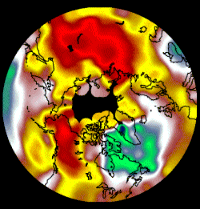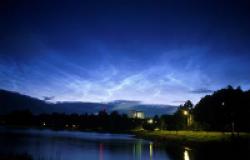What long term trends and decadal changes do you see occurring in the Arctic atmosphere, and what significance do they have?
Decadal changes and
long-term trends in the Arctic atmosphere
John Walsh
Professor of Atmospheric Sciences
University of Illinois at Urbana-Champaign
Global climate models suggest that the Arctic atmosphere will respond strongly to increasing concentrations of greenhouse gases. Hence the Arctic atmosphere could provide an early indication that greenhouse gases are affecting the earth's climate. However, the atmosphere of the Arctic, as in other regions of the globe, can undergo large decadal-scale and longer variations for reasons unrelated to changes in the radiative forcing by greenhouse gases. What do the recent data suggest in this context?
 |
| Measured changes in Arctic temperature from 1966 to 1995, in degrees Centigrade per decade. |
Much of the Arctic appears to have warmed at the surface over the past 40 years. The warming has been strongest over northern Eurasia and northwestern North America (including Alaska), as shown in the maps at http://faldo.atmos.uiuc.edu/RESEARCH/temptrends.html. The warming has been strongest in winter and spring, when it amounts to as much as 2–3°C per decade since 1960 in the areas of greatest warming. A similar seasonal pattern of warming has been detected in ice station and buoy data from the Arctic Ocean (Serreze et al., 2000). However, much of the warming during this period is likely due less to the greenhouse effect than to changes in the atmospheric circulation. A large-scale pattern of atmospheric pressure and winds, known as the Arctic Oscillation, brings relatively warm air to northern Eurasia and, to a lesser extent, northwestern North America when it is in a particular phase. This phase has been dominant for the past 20 years, while the opposite phase predominated in the 1960s. Hence the changing wind pattern since 1960 has favored warming in the same Arctic areas where the strongest warming has been detected.
While the Arctic warming of the recent decades may have multiple causes, longer temperature reconstructions from paleoclimatic data (tree rings, ice cores, temperature records) indicate that the Arctic was warmer during the 20th century than at any time since 1600 (Overpeck et al., 1997). This reconstruction is weighted toward the summer season, and it does also show a variety of decadal-scale swings, including a cooling of the Arctic from the 1940s to the 1960s. The reconstruction suggests that natural variations occur on the decade-to-century timescale, and it implies that such variations may have combined with greenhouse-gas changes during the past century "to drive unprecedented changes in the Arctic environment" (Overpeck et al., 1997, p. 1255).
The recent decades have also seen a shift of precipitation in the Arctic. The atmospheric circulation pattern that contributed to much of the post-1960 Arctic warming has also increased precipitation over subarctic Europe and the eastern North Atlantic (Dickson et al., 2000), and it has increased storminess in the Arctic. Recent assessments of 20th-century precipitation (IPCC, 1996) show that precipitation has increased by a greater percentage in the Arctic (65°N–85°N) than in any other latitudinal zone on the globe. Thus the Arctic has become a generally wetter as well as a warmer place over the past few decades, suggesting an acceleration of the hydrologic cycle in the Arctic. These changes have implications for soil moisture, vegetation, and river discharge. There are indeed indications that the seasonal "spike" in river discharge is occurring earlier in the spring in many Arctic rivers (Lammers et al., 2000).
Finally, there are recent indications of changes in the upper atmosphere of the Arctic. As part of an overall hemispheric trend, ozone concentrations have shown a broad decrease of 5–10% in the Arctic stratosphere. Perhaps more noteworthy are the brief occurrences of migratory ozone holes lasting several days. While the reductions of ozone during these Arctic events are large percentages of the total, the reductions cover much smaller areas and are less persistent than the Antarctic "ozone hole". The Arctic ozone reduction events appear to be dynamically forced (AMAP, 1997).
 |
| Polar "noctilucent" clouds in the mesophere. Courtesy of Timo Nousiainen , Department of Meteorology, University of Helsinki, Finland. Photographs are © Timo Nousiainen. |
References
AMAP, 1997: Arctic Pollution Issues: A State of the Arctic Environment Report. Arctic Monitoring and Assessment Programme, P.O. Box 8100 Dep., N-0032 Oslo, Norway, 188 pp.
Dickson, R. R., T. J. Osborn, J. W. Hurrell, J. Meincke, J. Blindheim, B. Adlandsvik, T. Vinje, G. Alekseev and W. Maslowski, 2000: The Arctic Ocean response to the North Atlantic Oscillation. J. Climate, 13, 2671-2696.
IPCC, 1996: Climate Change 1995: The Science of Climate Change (J. T. Houghton, L. G. Miera Filho, B. A. Callander, N. Harris, A. Kattenberg and K. Maskell, Eds.), Intergovern- mental Panel on Climate Change, Cambridge Univ. Press, Cambridge, U.K., 572 pp.
Lammers, R. D., A. I. Shiklomanov, C. J. Vorosmarty, B. M. Fekete and B. J. Peterson, 2000: Assessment of contemporary Arctic river runoff based on observational discharge records. J. Geophysical Research (Atmospheres), 105, in press.
Overpeck, J., K. Hughen, D. Hardy, R. Bradley, R. Case, M. Douglas, B. Finney, K. Gajewski, G. Jacoby, A. Jennings, S. Lamoureux, A. Lasca, G. MacDonald, J. Moore, M. Retelle, S. Smith, A. Wolfe and G. Zielinski, 1997: Arctic environmental change of the last four centuries. Science, 278, 1251-1256.
Serreze, M. C., J. E. Walsh, F. S. Chapin III, T. Osterkamp, M. Dyurgerov, V. Romanovsky, W. C. Oechel, J. Morison, T. Zhang and R. G. Barry, 2000: Observational evidence of recent change in the northern high-latitude environment. Climatic Change, 46, 159-207.
RELEVANT INFORMATION:
- Arctic Climate Change modeling at the University of Illinois at Urbana-Champaign
- Influence of Aerosols in the Arctic Climate




